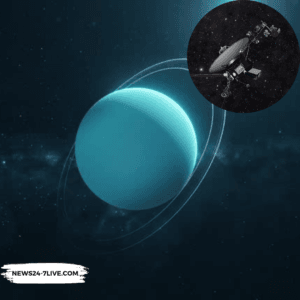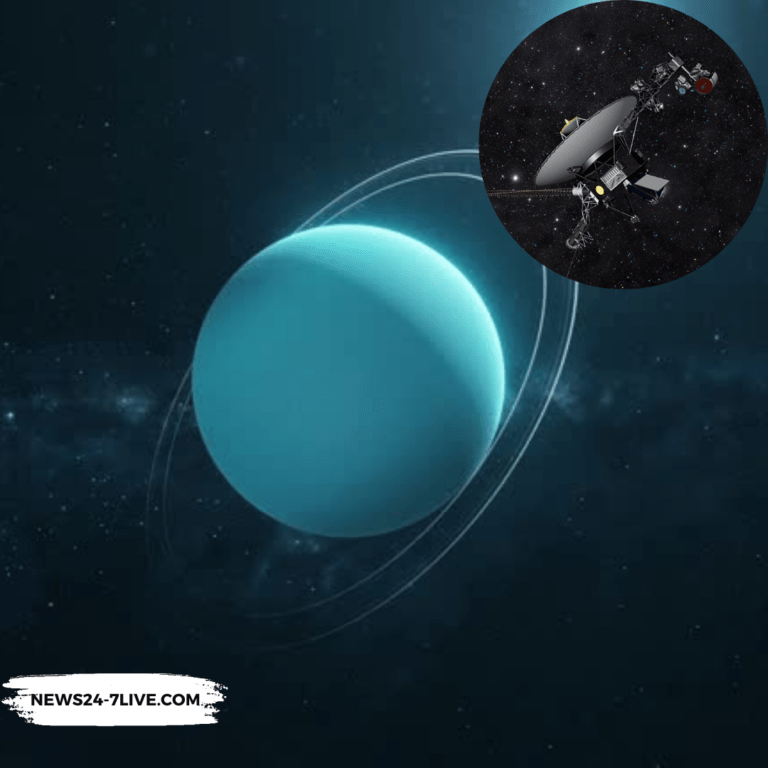According to Uranus latest news, the 38-year-old data from NASA’s Voyager 2 spacecraft, which made a flyby of Uranus in 1986. Now it has been reanalyzed.

The Voyager 2 mission is humanity’s first close encounter with Uranus. In January 1986, the spacecraft passed within 50,000 miles of the ice giant.
During this brief but impactful flyby, Voyager 2 detected an unusually intense radiation belt and found the magnetosphere to be unexpectedly low in plasma density.
To this day, flyby remains the only close-up study of Uranus, contributing a huge portion of our knowledge about the planet’s magnetic field, atmosphere and surrounding radiation environment.
According to Uranus latest news, Decades after Voyager 2’s flyby, a reanalysis led by Jamie Jasinski from NASA’s Jet Propulsion Laboratory uncovered that the spacecraft’s arrival coincided with an extraordinary solar wind event.
The unusual solar wind activity had compressed Uranus’s magnetosphere, temporarily creating an altered environment around the planet that Voyager 2 captured.
According to the study, Voyager 2 encountered Uranus’s magnetosphere during a rare condition, occurring only about 4% of the time, where intense solar wind altered the planet’s natural magnetic environment.
Voyager 2 became the only spacecraft to fly by Uranus in January 1986. This brief encounter lasting just five days shaped our current understanding of Uranus.
The flyby data suggested that Uranus possessed characteristics including a tilted axis, peculiar magnetic field and an unexpectedly sparse presence of plasma within its magnetosphere.
These findings defined Uranus as a hot mess with a magnetosphere that appeared highly irregular and unlike any other in the solar system.
According to Uranus latest news, New analysis reveals that Voyager 2’s encounter with Uranus occurred amid a rare solar event, which happens only about 4% of the time.
Just before the flyby, a solar wind from the sun swept across the solar system, compressing Uranus’s magnetosphere and likely pushing plasma out, fundamentally altering the magnetosphere’s appearance.
This rare cosmic coincidence may have misled scientists, causing them to interpret the unusual data as the norm for Uranus rather than a result of transient solar activity.
A planet’s magnetosphere is typically filled with plasma. However, the data showed a lack of plasma in Uranus’s magnetosphere.
The data revealed unexpectedly powerful radiation belts around Uranus, comparable to Jupiter’s, but without the usual plasma that drives this phenomenon.
This observation led scientists to assume Uranus had a highly anomalous magnetic field and unique internal structure.
According to Uranus latest news, the new findings suggest that these intense radiation belts were likely a temporary effect of the solar wind rather than a permanent feature.
The data initially led scientists to believe that Uranus’s moons were geologically inactive, as they appeared to contribute no ions to the magnetosphere.
The revised findings suggest that these moons could indeed be active, emitting ions into Uranus’s magnetic field in the absence of solar wind interference.
If not for the solar wind event, Uranus’s magnetosphere might resemble those of the other gas giants like Jupiter and Saturn. The study suggests that Uranus’s magnetic field may not be as irregular as once thought.
According to Uranus latest news, Uranus’s observed magnetosphere may have been a temporary snapshot rather than a representation of its usual state.
If this intense solar event had not occurred, Voyager 2 might have detected a magnetosphere that aligns more closely with those of other gas giants.
With only a single flyby lasting five days, Voyager 2 provided a glimpse of Uranus, insufficient for forming conclusions. Uranus’s distance also makes remote observation challenging with the Voyager flyby being the closest look scientists have had.
According to Uranus latest news, the latest findings support calls for a mission to Uranus. NASA’s planetary decadal survey in 2022 recommended launching a Uranus Orbiter and Probe as the next major mission, with an estimated launch in the early 2030s.
This proposed mission plans to conduct an orbital tour of Uranus, allowing for study of its atmosphere, magnetic field, moons and rings to gain a more accurate understanding of the planet’s characteristics.
While no new missions have yet reached Uranus, the James Webb Space Telescope has been pivotal in studying Uranus from afar.
Recent JWST images have revealed unseen aspects of the planet including its hidden rings, atmospheric weather patterns and additional details about its moons.
The findings from the Voyager 2 flyby and the reanalyzed data support the growing call within the scientific community for a mission to Uranus.
According to Uranus latest news, NASA is planning a new mission to Uranus that could launch as early as 2032. This mission aims to provide the first study of the ice giant’s atmosphere, magnetosphere and moons through orbital observations and atmospheric probes.
As Uranus and Neptune represent the most common type of exoplanets found in distant star systems (super-Earths and sub-Neptunes), studying Uranus would provide a comparative baseline for understanding these far-off worlds.
Uranus is one of the few planets in the solar system to orbit on its side leading to extreme seasonal changes that affect its atmosphere and potentially its magnetosphere.
Uranus’s magnetic field is unusual, tilted at a sharp angle compared to its rotational axis, which might have contributed to the unique observations made by Voyager 2.
Scientists are keen to understand how Uranus formed, what caused its unusual tilt and whether its moons have environments suitable for exploration, possibly even supporting subsurface oceans.















